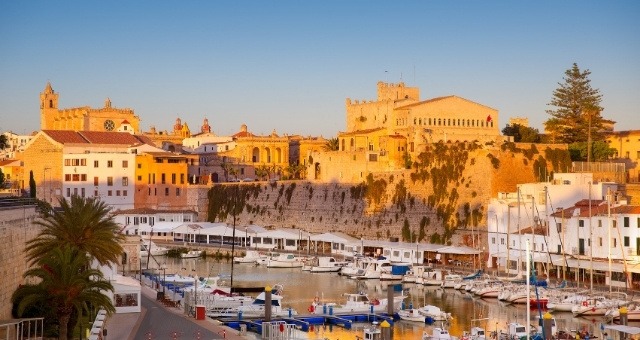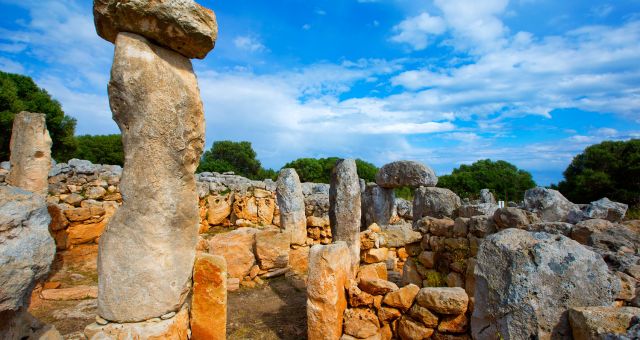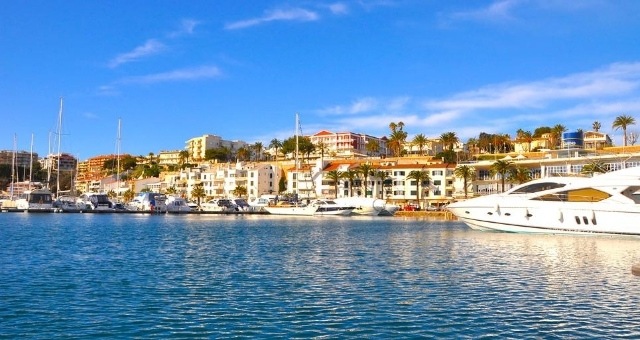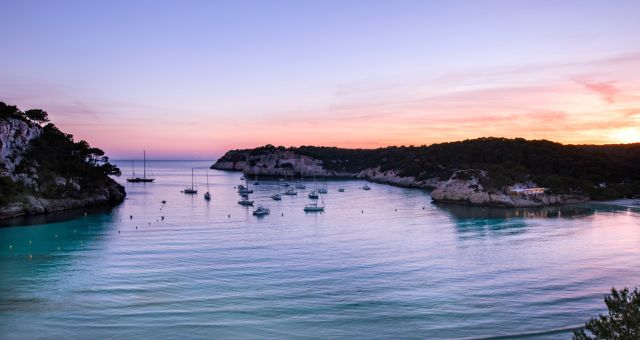Menorca
Balearic Islands, SpainMenorca (or Minorca) is the easternmost of Spain's Balearic Islands. Known for its pristine sandy beaches, crystal-clear waters and stunning landscapes, the unspoiled island is an ideal destination for tranquil holidays.
In our Menorca travel guide, you can find all the information you need about your vacation on the island: how to get there, top beaches and attractions, outdoor activities, food recommendations, holiday tips, and ferry schedules. Discover the best places to visit in Menorca and book cheap ferry tickets online on Ferryhopper without hidden fees!

The marina and the Old Town of Ciutadella in Menorca, Spain
Holidays in Menorca
Many people who want to travel to the Balearic Islands wonder which is better, Mallorca or Menorca? The answer is that it depends on what you are looking for. Mallorca is bigger, busier and much more famous, while Menorca is kind of a hidden gem. Menorca is not that touristy compared to Mallorca and the most popular of the Balearic Islands, Ibiza, so it has a more laid-back vibe.
Due to the absence of mass tourism, the island has retained its natural beauty and is the perfect destination for nature lovers. In fact, Menorca has been supporting sustainable tourism and the preservation of natural ecosystems for years, and the island has been designated as a biosphere reserve by UNESCO. So, if you are looking for a holiday of relaxation but also enjoy outdoor activities, Menorca is the place for you!
And how many days do you need in Menorca? Staying for 7 days is great to discover the gorgeous beaches, wild landscapes, unique monuments, and delicious local cuisine. If you prefer to go on a short break to Menorca, the peaceful island is also ideal for weekend beach holidays, as it's quite small and easy to access from continental Europe.
How to get to Menorca
You can travel to Menorca by ferry from the ports of Barcelona and Valencia in mainland Spain. The port of Barcelona is the one closest to the island. There are also daily crossings from Mallorca to Menorca, with the fastest ferry taking a bit more than 1 hour to reach the island.
Looking to learn more about ferry schedules and tickets for your trip to Menorca island? You can find detailed information about ferries to Menorca here.
What to do in Menorca
The tranquil island of Menorca is perfect for relaxing holidays, but it is also full of exciting things to do and see. From swimming in stunning turquoise waters, sunbathing on pristine beaches and strolling in picturesque towns and natural sites, Menorca has something for everyone.
Sounds exciting? Continue reading our Menorca guide and find all you need to know about your holidays on the island, including the best things to do in Menorca as well as useful information and Menorca tips.

View of the Cala Mitjana beach on the south coast of Menorca
Beaches in Menorca
Menorca has a huge range of incredible untouched beaches with amazing turquoise waters and white sand. Many of them are surrounded by dense pine trees. The most popular beaches are in the southwest of the island, while in the north, the landscape is wilder and the beaches more isolated.
Some of the best beaches in Menorca are:
- Cala Mitjana: this is one of the most popular and beautiful beaches in Menorca. It has white sand, shallow calm waters and it is backed by pine trees. From there, you can swim or hike to the smaller, but equally beautiful, Cala Mitjaneta beach. Bear in mind that there are no amenities, so make sure that you bring everything you need with you.
- Cala Turqueta: surrounded by pine trees, this heavenly beach has white sand and crystal turquoise waters that are ideal for snorkeling. You can find a small beach bar in the parking lot.
- Son Saura: located on the southwest coast of the island, these 2 long sandy beaches have shallow waters and are ideal for families.
- Cala des Talaier: close to Son Saura, you will find this small sandy beach with crystal-clear waters. It has no amenities or natural shade, so make sure that you bring all the essentials with you.
- Cala Macarelleta: this is one of the most photographed beaches in Menorca. The landscape is gorgeous, with turquoise waters and white sand backed by dense pine trees. The beach has a chiringuito (a small bar serving drinks and meals). We recommend arriving as early as possible during peak season, as it can get quite crowded.
- Cala Pregonda: located on the north coast of Menorca, this spectacular beach stands out for its golden sand, impressive rocks and several islets. You can get there on foot from the parking lot (about 35 minutes) or by boat. Bear in mind that the beach is quite isolated and has no amenities.
- Playa de Cavallería: this long beach is one of the most popular on the north coast. It has reddish-brown sand and crystal-clear waters, and it is ideal for diving and snorkeling. The beach can be reached on foot from the parking lot (around 10 minutes), where you can also find a small bar. Keep in mind that the sea can be rough when it's windy and that there are no other amenities at the beach.
- Cala Escorxada: this is an idyllic cove with untouched beauty, shallow turquoise waters, white sand and pine trees. You can get there by boat from Cala Galdana or on foot from the village of Santo Tomás (approximately 1 hour).
Tip: find out more about Menorca beaches on our dedicated blog.
Sightseeing in Menorca
Menorca has been inhabited since prehistoric times. Throughout its long history, it was invaded several times and the influence of its various occupiers is evident in the island's cultural heritage. From megalithic monuments and historic towns to impressive palaces and beautiful cathedrals, attractions in Menorca are so many that it feels like an open-air museum! The unspoiled island also has unique natural sights that you should explore.
Some of the top things to see in Menorca are:
- the archaeological site of Torre d'en Galmés
- the prehistoric megalithic chamber tomb of Naveta d'Es Tudons
- the Cathedral Basilica of Ciutadella (Catedral de Santa María de Ciudadela)
- the Cape Cavalleria lighthouse
- the Favàritx lighthouse
- the tower of Fornells
- the fortress of La Mola in Mahón
- the S'Albufera des Grau Natural Park
- the Cala Morell necropolis
- the s'Hostal quarries
Tip: if you find yourself in Menorca at the end of June, don’t miss the summer solstice Festes de Sant Joan, one of the most spectacular festivals in the Balearic Islands. Fireworks, bonfires and an impressive horse parade transform the city of Ciutadella for the occasion!

Impressive megalithic structures in Torre d'en Galmés in Menorca
Activities in Menorca
With its pristine canyons, lush woodland, an impressive range of beaches, and several miles of cycling and hiking routes, Menorca is an ideal destination for water sports enthusiasts and nature lovers. From sailing and stand-up paddleboarding to freediving and birdwatching, there are countless ways to discover Menorca's natural treasures and wildlife.
If you're thinking of going on walking holidays in Menorca, you can find plenty of guided and self-guided walks through the island's beautiful coasts and lush countryside. One of the top outdoor activities in Menorca is hiking (or cycling) the Camí de Cavalls, an ancient military path that runs the entire coastline of Menorca. You can also go hiking in Algendar, a ravine of unique natural beauty.
Several beaches in Menorca have centers for water sports and activities, such as kayaking, windsurfing and scuba diving. And of course, the crystal-clear waters of the island are perfect for trying out snorkeling in the Balearics.
Nightlife in Menorca
Is Menorca a party island? Well, not really. Nightlife in Menorca is more low-key than in the neighboring islands of Ibiza and Mallorca, but that doesn't mean it's not exciting!
In Menorca's capital, Mahón, Ciutadella and the island's resorts, you can find the most popular nightspots, including jazz bars, pubs, live-music venues, laid-back cocktail bars, and a disco. Several music festivals, parties and cultural events also take place in Mahón and Ciutadella in the summer.
Food in Menorca
Menorcan cuisine is based on ingredients typically used in the Mediterranean, but it has also been influenced by the culinary traditions of the island's past occupiers.
According to the locals, mayonnaise was invented in Menorca while the island was under French occupation. So during your vacation, you’ll have the opportunity to taste the creamy dressing in its birthplace!
Some local dishes and delicacies that you should try during your trip to Menorca are:
- oliaigu (delicious cold tomato soup with green peppers and garlic)
- caldereta de langosta (lobster stew)
- stuffed aubergines
- queso de Mahón (traditional white cheese made from cow’s milk)
- fish meatballs
- sobrassada and carnixulla (cured pork sausages)
- buñuelos (ball-shaped fritters with sweet filling)
- pudin de requesón (baked cheese pudding)
- Gin Xoriguer (traditional gin distilled in Mahón)
- pomada (a cocktail made with Menorcan gin and lemonade)

Beautiful decorative tiles on the wall of a small house in Alaior, Menorca
Villages and towns in Menorca
The main port and capital of Menorca is Mahón (or Maó in Catalan), located in the southeast of the island. The historic city is set around one of the biggest natural harbors in the world and can be easily explored on foot. The beautiful architecture, quaint alleyways, picturesque churches and colorful markets are guaranteed to enchant you.
The second biggest city and port of Menorca is Ciutadella, which is located on the west coast of the island. Surrounded by cobbled streets full of impressive mansions and palaces, the old capital's historic quarter is a must-see in Menorca.
The island also has several beautiful villages and smaller towns, where you can try Menorcan delicacies, visit artisan cobblers that make the traditional avarcas (Menorcan leather sandals), admire the charming architecture and relax at the local tapas bars and restaurants.
During your vacation in Menorca, we recommend visiting the following villages:
- Es Mercadal
- Alaior
- Sant Lluis
- Es Migjorn Gran
- Ferreries
Where to stay in Menorca
There are a variety of options for your accommodation in Menorca, especially in the peak season (mid-July to mid-September). For those interested in visiting historic monuments and going to cultural events, the towns of Mahón and Ciutadella have great hotels and apartments to rent as well as little family-run hostels. Mahón and Ciutadella also boast some of the best nightlife and shopping in Menorca.
If you wish to be close to the island's beaches, the best part of Menorca to stay is on the southeastern coast. In Son Bou, Cala en Porter, Punta Prima and Sant Tomàs, you can find numerous villas, hotels and rooms to rent.
If you're looking for quiet holidays in Menorca and prefer to be in touch with nature, there is also the option of camping. Wild camping in Menorca is prohibited, but there are 2 campsites: Camping Son Bou just off the town of Son Bou and Camping S’Atalaia on the south coast of the island.
Both campsites have all the necessary amenities for your vacation. Apart from setting up your own tent, Camping Son Bou also offers several chalets and furnished, pre-erected tents. In Camping S’Atalaia, you have the option to rent a tent if you don't have one. Camping is also a good accommodation option if you're looking to go on cheap holidays in Menorca.
For those who prefer to stay in a more peaceful environment away from the big resorts, the best place to go in Menorca is Binibeca, located on the southeastern tip of the island. This lovely seaside village is just a 20-minute drive from Mahón and the area has many bars and restaurants that offer great views of the ocean.
Regarding holidays in Menorca for families, the island has several resorts that offer services and activities to entertain visitors of all ages. One of the best areas to stay in Menorca if you are traveling with children is Cala Galdana. The resort is situated in a gorgeous bay with shallow waters, ideal for families with smaller kids.
Useful information about Menorca
First of all, some interesting facts about Menorca: Menorca is part of the Balearic Islands and is located in the Mediterranean Sea, close to the eastern coast of Spain. Its name comes from Latin and it means "smaller island" (in contrast to Mallorca, which means "larger island"). Menorca is a bit larger than Ibiza and is soaked in sunshine most of the year.
If you are a fan of heat and warm sunlight, the best time to visit Menorca is between June and August. Bear in mind that the island's beaches can get quite crowded during the summer. You can also enjoy the beach in September and October, as the sea is still quite warm.
You can find most of the island's supermarkets, mini markets, pharmacies, shops, banks, and ATMs in Ciutadella as well as in Mahón. Other towns and resorts also offer amenities for visitors. The main hospital is located in Mahón, while all of Menorca's major towns have medical centers.
Menorca has a small airport with 1 terminal, which mostly serves domestic flights as well as charter flights from European destinations. The airport is located about 4.5 km southwest of Mahón and approximately 45 km from Ciutadella. To get from the airport to Mahón, you can take bus route 10. The bus leaves you at Mahón’s bus station and the ride lasts about 15 minutes.
Tip: bear in mind that lots of bars, restaurants and hotels in Menorca are closed from November till March.
Important phone numbers for your stay in Menorca
Here are some useful contacts to keep handy when you travel to Menorca:
- Mateu Orfila General Hospital (Mahón): +34971487000
- Verge del Toro Medical Center (Mahón): +34971356942
- Canal Salat Medical Center (Ciutadella): +34971480112
- Ciutadella tourist information office: +34971484155
- Mahón tourist information office: +34971363790
- Balearic Islands Port Authority (port of Mahón): +34971363066
- Menorca - Mahón Airport: +34913211000
- National Police: 091
- Medical Emergencies: 061
- European emergency number: 112

A sunny day at the port of Mahón
Transportation in Menorca
During peak season, you can get to most towns and resorts in Menorca by bus, but you should bear in mind that the public transport network is not very extensive. Even though services are reliable and quite cheap, they are operated by 3 different companies, which can be a bit confusing for visitors.
Mahón and Ciutadella, the two biggest cities in Menorca, are connected with frequent services. From Mahón, you can get to some beaches on the east and south coast of the island, while from Ciutadella, you can catch the bus to beaches in the west and southwest.
For more information on bus routes and how to travel around Menorca by bus, check out the official MOU-T Menorca website (Mobility Department of the Island Council).
Menorca also has taxi services. Fare prices are based on distance and taxi ranks are called paradas de taxi. There is also a water taxi service between Mahón and Es Castell.
Alternatively, you can rent a car or a scooter to visit the more secluded areas of Menorca. Mahón, Ciutadellas and some of the island's resorts have plenty of car hires. If you would like to get around Menorca at your own pace, the island also has several bike rentals, where you can find a wide range of both city and mountain bikes.
Tip: be careful not to park in places that have the sign "vado permanente." The sign means that parking is prohibited and your car might be removed by the police.
Ports in Menorca
Menorca has 2 ports: Mahón (or Maó) on the east coast and Ciutadella on the west coast. Ferries from Valencia arrive at the port of Mahón, while ferries traveling from Barcelona arrive either in Mahón or Ciutadella.
The distance between Mahón and Ciutadella is approximately 45 km and the two cities are connected by regular bus services.
Island hopping from Menorca
Menorca is located very close to Mallorca, so why not take the ferry and explore the biggest of the Balearic Islands too? Most ferries depart from the port of Ciutadella and arrive at the port of Alcúdia. This is the fastest way to travel by ferry from Menorca to Mallorca, as the service usually runs more than 3 times per day and lasts a bit more than 1 hour.
There is also 1 weekly ferry crossing from the port of Mahón to Palma, the capital of Mallorca, lasting 6 hours.
On Ferryhopper's Map of ferries, you can see all the available Menorca ferry routes and easily organize your island hopping in the Balearics.
Menorca ferry: schedules and tickets
Ferries to Menorca from Spain depart from the port of Barcelona and the port of Valencia. The ferry route from Barcelona is served more frequently and the trip duration is shorter. Ferries to Menorca from Barcelona arrive both at the port of Ciutadella and the port of Mahón, while ferries departing from Valencia arrive at the port of Mahón. There are also seasonal routes to Menorca from Toulon in France.
More specifically, the Menorca ferry routes from mainland Spain are the following:
- Barcelona to Menorca: it is served daily in the high season and the trip duration ranges from about 3.5-9 hours.
- Valencia to Menorca: there is normally 1 weekly ferry crossing and the journey takes about 16 hours.
- Toulon to Menorca: it operates with 1-2 weekly connections, lasting 17 hr.
You can also catch the ferry to Menorca from Mallorca. The route is served daily, with the fastest ferry taking a bit more than 1 hour to reach the island.
Ferry timetables are subject to change depending on the season. You can find real-time schedules and compare Menorca ferries on Ferryhopper, easily and quickly. For more information about getting to Menorca, check out our blog post and travel like a pro!

View of sailing boats from Menorca at sunset
Book ferry tickets online to Menorca
Book cheap ferry tickets to Menorca online on Ferryhopper without hidden fees. Compare crossings, discounts and ticket prices, and discover the best of Menorca with our travel tips. Your dream holidays in the Balearic Islands are just a few clicks away!
Menorca ferry schedule
View the complete ferry schedule from and to Menorca for the upcoming week. Find up-to-date trip information, including departure and arrival dates and times, ferry operators and ticket prices.